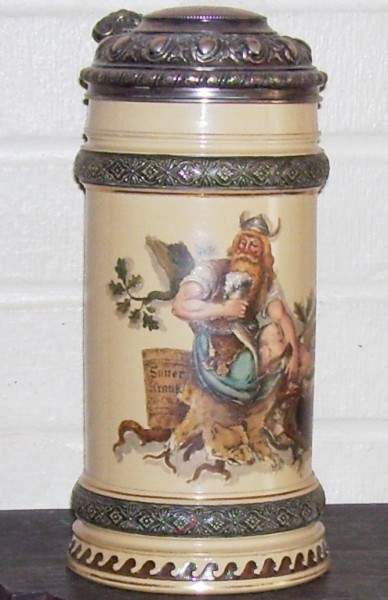
“I wish you beer stein collectors would learn this one easy German history lesson!
(Says Hermann, the German, a.k.a. Stephen L. Smith. The original version of this article was started in 2006, and published in PROSIT sometime much later.)
_______________________________________________
Every time I hear you beer stein collectors call me and my men “Vikings” we roll over in our graves. So to try to stop all that unnecessary activity, I am addressing this article to all you in SCI land (and now the world!)
My real name is Arminius. I am also known as Armin to some. [1]
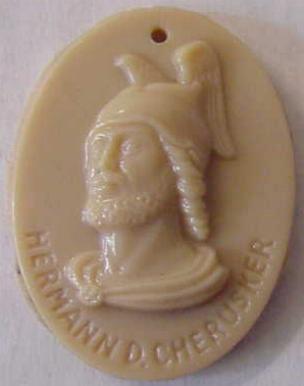
.
I am a German! I am a good old German, an “Alt Deutcher! I am famous in my homeland. It is a shame you Americans can not call us old timers by our correct names, but then you are the ones that started calling our stoneware bier krugs, “steins,” are you not?
In German to English, my name Armin was interpreted as “Hermann” by Martin Luther and to distinguish me from other Germans of the same name, I was called “Hermann “The German.” As I said before I’m pretty famous in Germany. My warriors, now known as the Cherusher or Cheruscans along with several of other Germanic tribes “whipped the snot” out of three Roman Legions with their supporting units of Cavalry and auxiliaries at the famous battle of “Teutonburg Forest” in what is now northern Germany. We killed 20,000 top of the line Roman soldiers back in 9 A.D.!
The Varus Disaster.
In Rome back then they called it the “Clades Variana” (The Varus Disaster.) It was simply unheard of at the time, nothing like it had happened before; and still you people / stein collectors call us “Vikings!”
The Roman Emperor, Augustus Caesar on hearing the news of the great defeat, yelled out (and probably wept), “Varus, give me back my legions!” And hundreds of years later my countrymen were still calling me, Hermann, “Befreier Germaniens”, or the “German Liberator.” But some of you 21st century “E-nerds” still persist in calling us “Vikings.” Now if you don’t want to acknowledge that we are of a great German heritage, hen call us “Teutons” or “Nordics”, or call us the “Cherusci”, the official name of my tribe, but please stop calling us Vikings!
A 1698 version of Hermann; quite the savage, hey? And one has just got to love that pony tail.
The Vikings lived in Scandinavia and were of historical significance about 800 years after me and my tribe. The derivation of the term “Viking” is usually traced to the old Norse “Vik” , meaning inlet of water or bay. The original Vikings in this interpretation were seafarers who lurked in their boats in any of the steep sided sounds that gouge Norway’s deeply indented North Sea coast, waiting to pounce on cargoes of ships traveling the “North Way.” (2)
Please let me, Hermann, emphasize this one point. The Vikings while fighting never wore helmets with wings and it is quite doubtful any of my fellow Germans did either.(4) The wings on the helm would have caught an enemy’s sword or club and my neck might have been broken on the spot. Although I may have worn one of these helmet at my tribal coucil to show off my lofty position. (5)
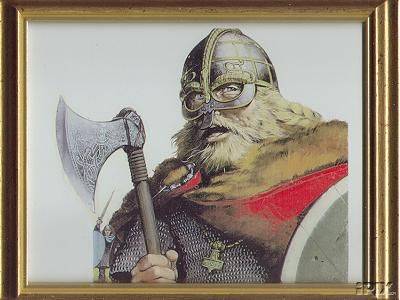 A representation of what a real Viking looked like in battle gear.
A representation of what a real Viking looked like in battle gear.
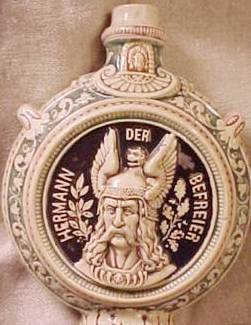 A pottery flask, German Ca. 1900, showing a profile of Hermann wearing his famous winged helmet.
A pottery flask, German Ca. 1900, showing a profile of Hermann wearing his famous winged helmet.
There is evidence that “The Celts”, a tribe of Northern Huns that pre-date me and my men by several centuries, had metal helmets with representations of bronze “Horns” on them. It has never been proven that the Celts used them in battle, and they were probably ceremonial. (6)
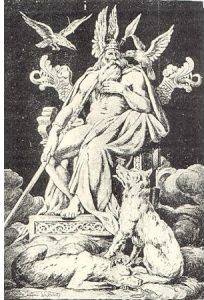 Odin and his ravens and wolves, a typical rendition of his extra large winged helmet on a late 19th century print. (Illustration compliments of “Ye Old Viking Bookshop”)
Odin and his ravens and wolves, a typical rendition of his extra large winged helmet on a late 19th century print. (Illustration compliments of “Ye Old Viking Bookshop”)
Now back to the battle;
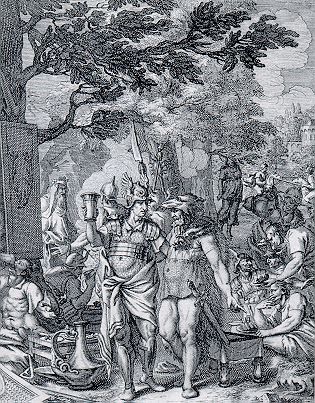 Hermann, who was a leader of one of the Roman auxillery units is shown with his leader, Roman General Varus, who he later betrayed.
Hermann, who was a leader of one of the Roman auxillery units is shown with his leader, Roman General Varus, who he later betrayed.
It was said of the battle where we creamed the Roman General Varus and his troops: “Nothing was bloodier than this “Gemetzel” (butchery / carnage) in sumps (swamp / bog) and forests.” (3) But still you beer steiners don’t quite comprehend. The loss of three entire legions under “Publius Quinctilius Varus was one of the, if not the greatest military disaster in Roman History. Hermann, who was a leader of one of the Roman auxiliary units is shown with his leader above: , Roman General Varus, who he later betrayed. A historical poll completed in 2001 asked the question: “which best describes Arminus (Hermann?)” Of the 101 votes cast, ‘Freedom Fighter’ got 34%, ‘Military Genius’ got 24%, ‘Schemer’ got 24%, and only 12% thought I, Hermann, was a traitor, which I am certain my leader, General Varus thought!
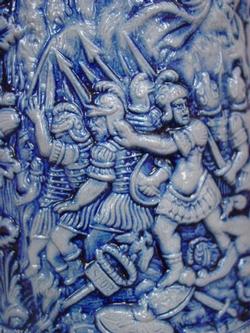 Detail of a 1 liter salt glazed stoneware stein showing the Roman Imperial “Eagle” Standard being discarded (bottom left.) A little artistic license perhaps, as it is doubtful this would have been allowed to happen even in a retreat, until the next to last man dropped. However it does give the viewer an idea of the complete overwhelment of the German forces led by Arminius and his father Segimerus. (The stein was a gift to me from Jack Gustad, [deceased], who was very well liked retired Army Colonel, and an active fellow Gambrinus Beer Stein Club member.)
Detail of a 1 liter salt glazed stoneware stein showing the Roman Imperial “Eagle” Standard being discarded (bottom left.) A little artistic license perhaps, as it is doubtful this would have been allowed to happen even in a retreat, until the next to last man dropped. However it does give the viewer an idea of the complete overwhelment of the German forces led by Arminius and his father Segimerus. (The stein was a gift to me from Jack Gustad, [deceased], who was very well liked retired Army Colonel, and an active fellow Gambrinus Beer Stein Club member.)
There is a statue of me, called the “Hermannsedenkmal”, that does show me wearing a winged helmet. It honors the memory of the battle I have been telling you about. Ernst von Bandel erected the 385 meters high monument (above sea level) in 1875, but he was not particularly interested in historical accuracy but in finding a “correct and pleasant” surrounding. These he found on the “grotenburg”, at the gates of the traditional town of Detmold. (7) The date of building that statue dedicated to me gave the “bier krug” makers plenty of time to use his artistic license of the winged helmet that had been previously established by Richard Wagner. Oh, but now I get ahead of myself.
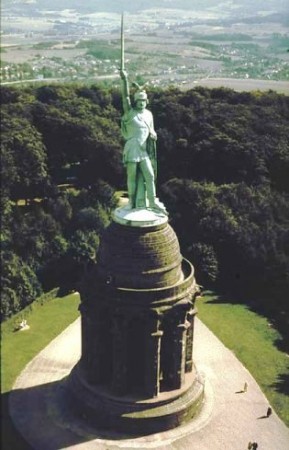 The statue of Arminus, called Hermannsdenkmal” is close to the town of Detmold, built by Ernst von Bandel in 1875 to honor old Hermann.
The statue of Arminus, called Hermannsdenkmal” is close to the town of Detmold, built by Ernst von Bandel in 1875 to honor old Hermann.
It was not Hollywood’s rendition of the “Vikings” that has caused this major misunderstanding of the winged helmets. Probably more to blame then “those dudes” is the much earlier form of entertainment, the opera! Richard Wagner (1813-1883) and his theater’s set and costume designers did more to unconsciously establish the dress of the “Old Germans” in the Nordic style of the Scandinavians than anyone else.
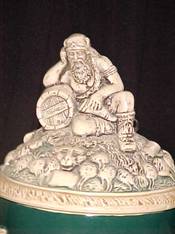 One of Hermann’s men with a drinking horn used for drinking mead (and later beer.) This photo is of the lid and finial on a great 3 liter colored pottery stein. Circa 1890. [FWTD]
One of Hermann’s men with a drinking horn used for drinking mead (and later beer.) This photo is of the lid and finial on a great 3 liter colored pottery stein. Circa 1890. [FWTD]
The Nordic myths of Siegfried and Brunnhilde especially fascinated Wagner. He decided to use the tales as a basis for four epic operas to be performed under the title “Der Ring des Niebelungen.” Wagner referred back to those Norse tales when he comprised “Der Ring .” He combined the Norse Saga of the Volsungs with the German epic, the Nibelunglied.
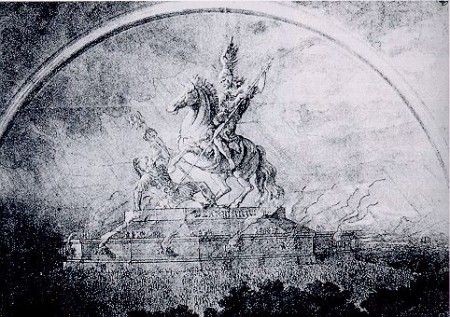
Wagner relied less heavily on the Nibelungenlied that some believe and instead turned to the more pagan “Volsung saga” with its tale of Sigurd , the dragon slayer, and the Valkyrie Brynhild. He greatly expanded the tale and as usual, wrote his own librettos, writing the story in reverse order, he began composing “Das Rheingold” (The Rhine Gold”) in 1853. He would go on to complete “Die WalkUre “(The Valkyries} in 1854, “Siegfried” in 1871 and “GotterdAmmerung” (Twilight of the Gods) in 1874. [8]
Steve, my friend and German Krug collector has a theory and he admits it is hard to prove over 150 years later, but I Hermann, will advance it anyway. Steve believes Wagner got this costume ideas from a book that had been published and widely read in 1836. It was called “The History of the German People, ” authored by Carl Mayer – and to Steve’s, very limited knowledge and research in this subject, was one of the first times Hermann is seen wearing a winged Helmet.
.
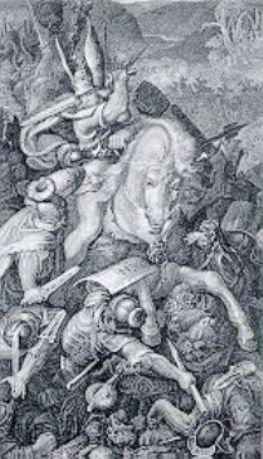 Carl Mayer’s print of Hermann, the warrior with the helmet.
Carl Mayer’s print of Hermann, the warrior with the helmet.
Years later , by the time the final episode of Wagner’s “The Ring” series had been produced and many editions of “The History .” had been read, the German ideal of what the daily garb of the old Germans has been well established. Of course the winged helmet of the fearless leaders tagged along. It was a short hop from those book illustrations, as well as the opera posters to those images produced in the beer stein workshops of an industrial Germany, The rest as they say is “Beer Stein History.
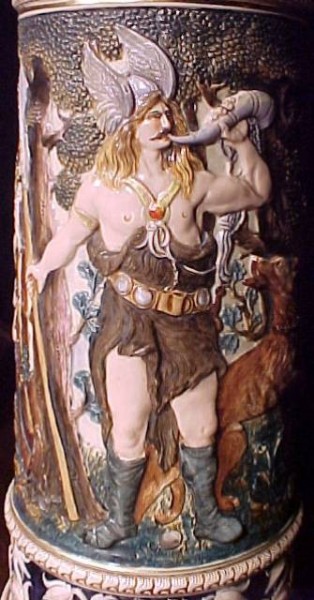 Detail of a three liter pottery beer stein showing Hermann blowing an oxen, or buffalo, horn to rally his tribe. A lot of the “Die Alten Deutchen” pottery steins show these horns being used a drinking vessels . To see some actual antique drinking horns, see the TAB by that name, this web site.)
Detail of a three liter pottery beer stein showing Hermann blowing an oxen, or buffalo, horn to rally his tribe. A lot of the “Die Alten Deutchen” pottery steins show these horns being used a drinking vessels . To see some actual antique drinking horns, see the TAB by that name, this web site.)
.
Due to recent historical excavations started in 1987 by an English chap, it has been determined that the actual site of the battle was just north of the Town of Osnabrueck; by a small mountain called “Kalkriese” (Lime Giant.) All of these are about 50 miles to the North-East of the “Hermannsdenkmal.” Of course none of this was known when Von Brandel built his monument to Hermann. German history students are now calling this new site “Varusschhlacht” (Varus’s Battle) to distinguish this new location from the original “Teutonberger Forest” (9)
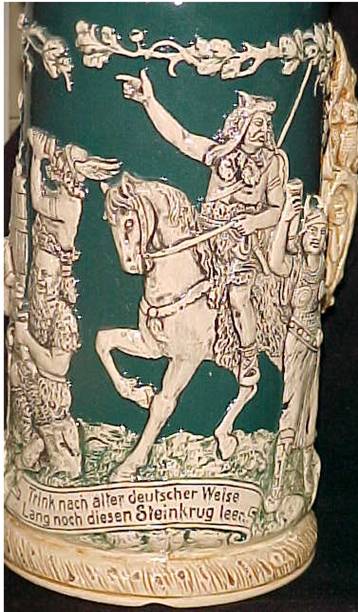
Here I am again in bear skin, being offered beer or mead by my woman “Tusnelda”, who is also dressed in old German or Teutonic garb. Detail of a 3 liter pottery relief beer stein (the lid was shown above) saying: ” Empty now those foaming beer steins as did those Germans in ancient times!” (Compliments of the translation web site by Les Hopper (a now deceased SCI member) [10]
As one can see by the photos in this article , I , Hermann, have been represented on many “alt Bier Krugen.” On some of these vessels the makers even put the words “Alt German” on them , and you collectors wil still look at these steins 100 or so years later and say, .(you guessed it) . Vikings . I am sometimes shown on these steins as wearing an animals hide (mostly a bear’s) as a head and neck protector.

A woodcut from 1717 [?], showing Hermann and his troops dressed, but not as Barbarians. Of note, not a winged helmet anywhere! SPQR” , stands for “Senatus Populusque Romanus.” (“The Senate and People of Rome.”) This Latin motto of the Ancient Roman Empire that sounded imperial glory for millennia.
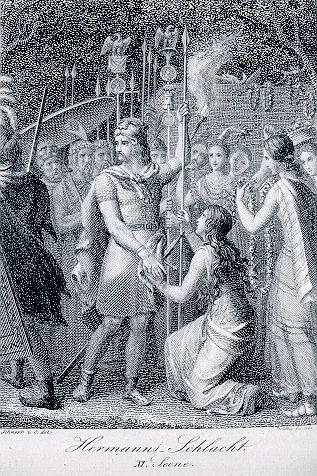
Hermann wearing a Bear’s skin head dress along with Roman style attire, shown on a copper plate print, dated 1823.
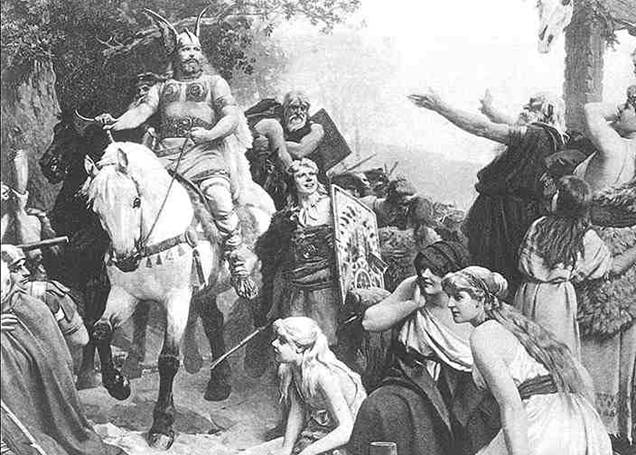
“Hermann’s triumph over the Romans,” by Paul Thumann, C. 1894
.
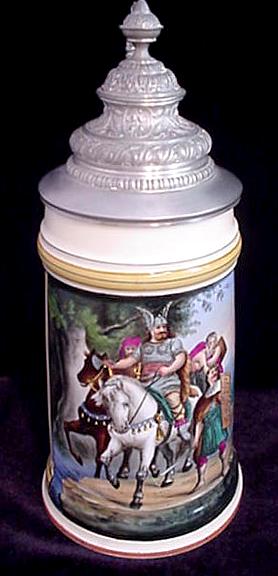 A 1/2 liter porcelain stein showing Hermann, taken from Mr. Thumann’s painting.
A 1/2 liter porcelain stein showing Hermann, taken from Mr. Thumann’s painting.
xxxxxxxxx FOOTNOTES xxxxxxxxxxxxxx FOOTNOTES xxxxxxxxxx
(1) “Hermann” in English
(2) “VIKINGS- The Battle at the End of Time”, Tony Allan, Duncan Baird
Publishers, London, 2002
(3) F.L Florus, “OUTLINE OF ROMAN HISTORY” – about 120 years after
the battle.
(4) Tacitus, a Roman historian in the first century writes of the German fighters:
“With coats of mail very few are furnished, and hardly upon any is seen a head-piece or helmet.” [Per: “Internet Medieval Sourcebook”].
(5) Some of the slipware pottery German “steins” made for the
Scandinavian market, show the Norse god “Odin” with a winged helmet; again
with the idea of showing his lofty position in relationship with all the other
gods.
(6) The Epic of Man, Golden Press, NYC (1962), “Celts and Scythians”, page 95
(7) http://www.hermannsdenkmal.de/region.htm. The actual site of the battle has now been accepted as being some 50 miles NW of where this monument is. This is due to serious archaeological excavations taking place in the last 20 years.
(8) Various “Google” web sites.
(9) Project “Lime Giant” web site: http://translate.google.com/translate?hl=en&sl=de&u=http://www.geschichte.uni-osnabrueck.de/projekt/start.html&prev=/search%3Fq%3DKalkriese%26hl%3Den%26lr%3D%26ie%3DUTF-8%26oe%3DUTF-8%26sa%3DG
(10) http://members.cox.net/leshopper/expndx.htm
CREDITS: [1] Editorial review assistance by Barney, “Gambrinus Stein Club”. [2] My thanks to Les Hopper (SCI – Deceased), for his web site, for providing translations used: http://members.cox.net/leshopper/expndx.htm EDITOR’S NOTE: This information has now (2010) been put behind locked doors in the “Members only” section of The SCI web site! What a damn shame! [3] This article is dedicated to my old friend and fellow collector (Gambrinus Stein Club) Jack Gusted, who started me on this project years ago by writing his brief explanatory article about Hermann in “PROSIT”.
Copyright 11-19-2005 by Stephen L. Smith,
[END OF ORIGINAL ARTICLE – SPOK]
___________________________________________________________
OTHER BEER STEINS SHOWING HERMANN AND THE BATTLE, OR HIM AND HIS MEN, OR WIFE.
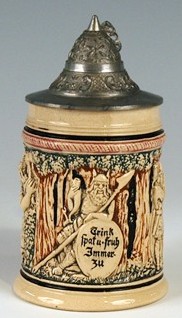 A .3 liter pottery relief stein. Hermann [probably], his horn and his spear. Circa 1900.
A .3 liter pottery relief stein. Hermann [probably], his horn and his spear. Circa 1900.
.
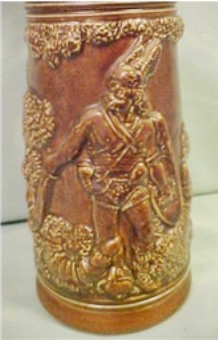 A newer .5 liter (1970- 2000) version by “King.
A newer .5 liter (1970- 2000) version by “King.
![1R HERMANN - ABSCHIED VON TUSNELDA [wife] -8.5 INCH](http://www.steveonsteins.com/wp-content/uploads/2010/05/1R-HERMANN-ABSCHIED-VON-TUSNELDA-wife-8.5-INCH.jpg) Hermann and his wife ‘Trusnelda’, shown on a half-liter cream and green potter relief beer stein. Circa 1890.
Hermann and his wife ‘Trusnelda’, shown on a half-liter cream and green potter relief beer stein. Circa 1890.
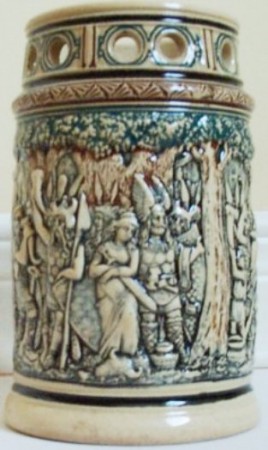 A Circa 1900 scarce pottery relief “puzzle mug.”
A Circa 1900 scarce pottery relief “puzzle mug.”
For more into on these mugs, please see: http://www.steveonsteins.com/in-the-near-future-2-1-2
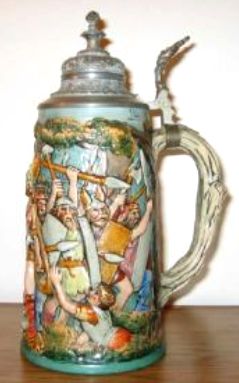 A D & B relief pottery stein found in many versions
A D & B relief pottery stein found in many versions
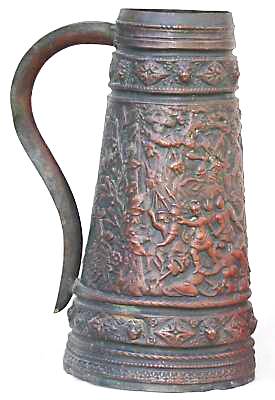
A 3 liter “copper clad” version of the Westerwald stein (sans lid.)
For more info on “copper clad” steins please see: http://www.steveonsteins.com/copper-clad-beer-steins-draft
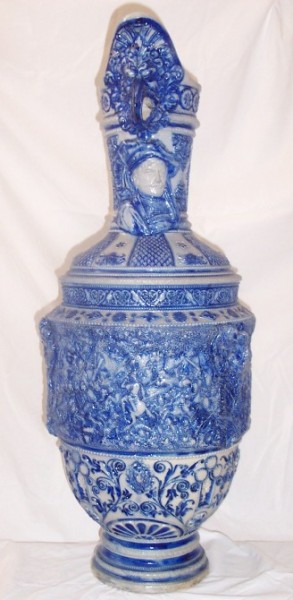 A massive 4.5 or 5 liter salt glazed stoneware serving stein. wrap around battle scene. Made by Hanke i believe.
A massive 4.5 or 5 liter salt glazed stoneware serving stein. wrap around battle scene. Made by Hanke i believe.
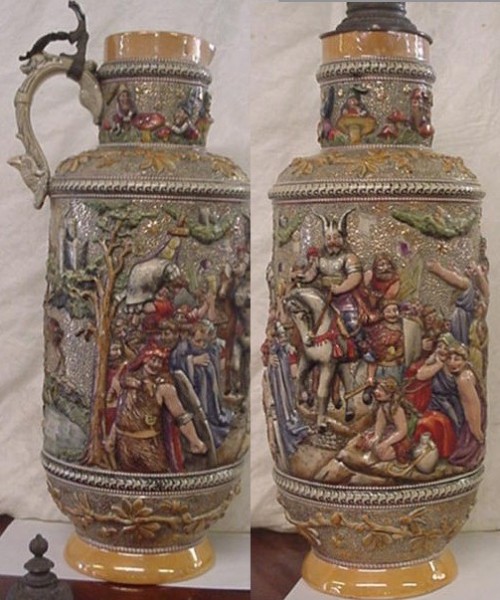
A 21.5 inch tall serving stein by Diesinger, from Thumann’s painting.
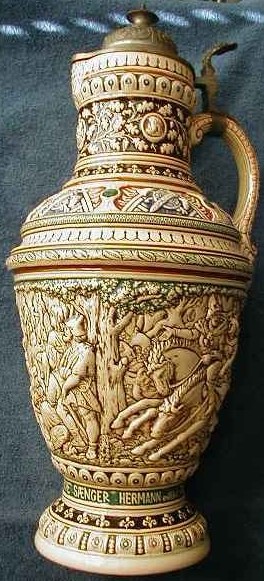
A 4.5 liter pottery serving stein showing Hermann and Trusnelda’s elopement. His father-in-law was not happy! Much later her father gave the Romans (seeking revenge for the Varus disaster) his daughter’s and Hermann’s location. She and her son were caught and taken to Rome where they were paraded as war prizes. Hermann escaped the Romans to fight another day, only to be later knifed to death by his own tribesmen.
BELOW: Additional info that was added after the article was written in 2006. With a few additional photos of Herr Hermann on beer steins.
Compliments of / and to . http://www.straightdope.com/
http://www.straightdope.com/mailbag/mhornedhelmet.html
Dear Straight Dope:
Did Vikings really have horns on their helmets? —Thad in San Antonio
SDSTAFF bibliophage replies:
“No self-respecting Viking warrior ever wore a horned helmet in battle–they weren’t that dumb. As anyone who has done any slaughtering can tell you, horns provide nothing more than a good handhold to steady your work while you’re slitting someone’s throat(or hacking off their neck.) Nor did Viking warriors wear wings on their helmets, as they were commonly depicted doing before the horned image took over. Popular belief to the contrary isn’t entirely baseless, though. Historical and archaeological evidence indicates that priests among the Norse and earlier Germanic peoples did wear headgear with horns (but not wings) in religious ceremonies. Furthermore, the ancient Celts wore helmets with wings (or other weird stuff), also for ceremonial purposes. The use of horned headdress in religious ceremonies wasn’t limited to Germans and Celts–there are dozens of examples from around the world dating back to the earliest civilizations.”
 A hand painted scene of Hermann and his drinking horn. This is on a .5 liter V & B Mettlach, which comes with a silver plated lid made by WMF. The painting is reminiscent of a “van Hauten” piece, but there is no signature.
A hand painted scene of Hermann and his drinking horn. This is on a .5 liter V & B Mettlach, which comes with a silver plated lid made by WMF. The painting is reminiscent of a “van Hauten” piece, but there is no signature.
.
“Who started the idea that Vikings wore a pair of horns on their helmets in battle? Ancient Greek and Roman writers got the ball rolling. They described the inhabitants of northern Europe wearing all manner of outlandish things on their heads. For example, Plutarch described the Cimbri, the likely ancestors of at least some of the Vikings, wearing “helmets, made to resemble the heads of wild beasts,” horns included. Diodorus Siculus had earlier described a similar habit of the Gauls, who were a Celtic rather than Germanic people. The Gauls, he writes, wore winged helmets or helmets with horns or antlers or whole animals attached. (The tradition continues apace; I’ve met Celts with all kinds of crazy stuff coming out of their heads, mostly but not entirely limited to the one day each year when green beer miraculously flows like water.)”
“Archaeological finds, all but one of which date from the ninth century B.C. to about the seventh century C.E., back them up on the horn thing, but only to a degree. The ancients implied that such helmets were used in battle, but a ceremonial use is more likely. The finds consist mostly of images from rock carvings, horn carvings, coins, engraved metal objects, etc. A few actual horned helmets have been found; most are Germanic helmets from Denmark, but one is a Celtic model dredged from the Thames. None of these ceremonial horned helmets match the stereotypical image of a metal helmet with ox horns attached. For example, two Bronze Age horned helmets unearthed at Viksø, Denmark sport long twisting horns made of metal. The Thames helmet to my mind suggests an ancient priest who got drunk enough to think it was a good idea to wear Madonna’s cone bra on his head.”
 A half liter pottery stein with a ‘false bottom’ Circa 1900. A little known fact, but all Germanic tribes had harpists. It was a high position in the tribe, sort of a “right hand man” to the Chief. Sometimes the Harpist was used for ambassadorial mediation functions with other tribes.
A half liter pottery stein with a ‘false bottom’ Circa 1900. A little known fact, but all Germanic tribes had harpists. It was a high position in the tribe, sort of a “right hand man” to the Chief. Sometimes the Harpist was used for ambassadorial mediation functions with other tribes.
For more info see: : http://www.steveonsteins.com/harpists-on-beer-steins-a-couple-of-reasons
“Even the latest of these archaological finds, with one exception, are a century or two shy of the Viking Age proper, which is somewhat arbitrarily reckoned to have started in A.D. 793, the year of the Viking raid on Lindisfarne. The exception is the horn-wearing man depicted on the ninth-century Oseberg tapestry discovered in Norway a hundred years ago. It may represent a continuation of the pre-Viking ceremonial use of horned headdress by the Norse. That wouldn’t be too surprising; Norse culture didn’t radically change in 793. On the other hand, it could be a new custom imported from the east. Herodotus reported that the Thracians, the prototypical steppe barbarians to the ancient Greeks of his day, wore horned helmets. It’s possible the Vikings encountered something of the same sort in their travels through Russia or elsewhere in the east.
The first image of horned helmets to be found was an engraved horn from Gallehus, Denmark, discovered in 1734. However, European artists had begun portraying ancient (pre-Viking) Germans wearing horned helmets as early as 1616, on the authority of the ancient writers. Since the ancients weren’t clear on the ceremonial purpose of the helmets, they were often used in battle scenes. The use of horned helmets in German heraldry during the Middle Ages can probably be attributed to the same authors.
Where did Malmström get the idea for a horned helmet? By the time the poem came out, plenty of archaeological evidence indicated that horned headgear was used in ancient times, although it still wasn’t clear that such helmets were purely ceremonial and may have disappeared before the Viking era. At any rate, Malmström’s idea didn’t catch on right away. While the illustrations for some English translations of the poem also featured horned helmets, the winged variety remained the norm for several more decades.
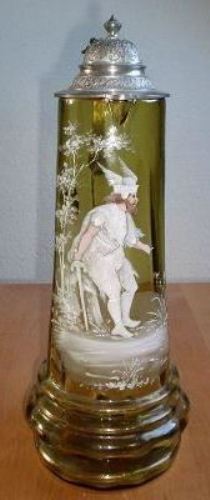 A Theresienthal white enameled glass serving stein. Ca. 1890. For more on Theresienthal steins see: http://www.steveonsteins.com/theresienthal-glass-steins-the-guide
A Theresienthal white enameled glass serving stein. Ca. 1890. For more on Theresienthal steins see: http://www.steveonsteins.com/theresienthal-glass-steins-the-guide
“In Wagner’s operas, horned helmets are now most closely associated with the Valkyries, but as originally staged the Valkyries wore helmets with wings. (The Valkyries didn’t get horny until Wagner died.) The only major figure in the whole cycle who wore a horned helmet in the early productions was Hunding. Those who have somehow managed to stay awake through the entire four-hour production of Die Walküre may remember Hunding as the boor who objected to his wife sleeping with her brother. Wagner and his costume and set designer Carl Emil Doepler probably borrowed the idea not from the few scattered images of Vikings wearing horned helmets, but from the costumes in stage plays about ancient pre-Viking Germans.
The horned helmet didn’t immediately replace the winged helmet. The trend grew slowly until the early 1890s, when the one started horning in on the other’s territory, especially in German and English illustrated children’s books about Vikings. After that it was bully for horns while wings just fluttered. Winged helmets finally crashed about the time of the First World War and weren’t seen much thereafter until reincarnated for Thor and Asterix, a comic rebirth if I ever saw one.”
![1R a HERMANN WITH VERY LARGE WINGS - ENAMELED SERVING STEIN [2]](http://www.steveonsteins.com/wp-content/uploads/2010/05/1R-a-HERMANN-WITH-VERY-LARGE-WINGS-ENAMELED-SERVING-STEIN-2.jpg) Another Theresienthal glass serving stein, and set with all white enameling of Hermann with the matching glasses. Circa 1890.
Another Theresienthal glass serving stein, and set with all white enameling of Hermann with the matching glasses. Circa 1890.
“If Viking warriors didn’t wear winged or horned helmets in battle, what did they wear? Many probably didn’t wear helmets at all. Writing about seven centuries before the Viking era, the Roman historian Tacitus says most Germans didn’t. But we needn’t take his word for it. Contemporary Viking era artwork shows roughly half of Vikings in battle bareheaded, while the rest wear unremarkable dome-shaped or conical helmets. Few helmets have survived from the Viking Age, probably because the rank-and-file wore leather helmets that didn’t last. The few metal ones that have been discovered presumably belonged to the richest Vikings. Some are iron “spectacle” helmets, so called because they have bronze eye-and-nose guards that look a bit like a pair of glasses except that there’s nothing at all nerdy about them. I’m willing to bet that anybody who called their wearers “four-eyes” was soon made to see the light–or stars.”
Further reading:
“The Invention of the Viking Horned Helmet” by Roberta Frank in InternationalScandinavian and Medieval Studies in Memory of Gerd Wolfgang Weber (2000), edited by Michael Dallapiazza et al.
“The Origin of the Imaginary Viking” by Johnni Langer in Viking Heritage Magazine, December 2002 –SDSTAFF bibliophage Straight Dope Science Advisory Board.
And finally, the scene again of Herman (with the “winged” helmet, getting a horn full of mead from his wife. This on a HR “incised” stein (#429):
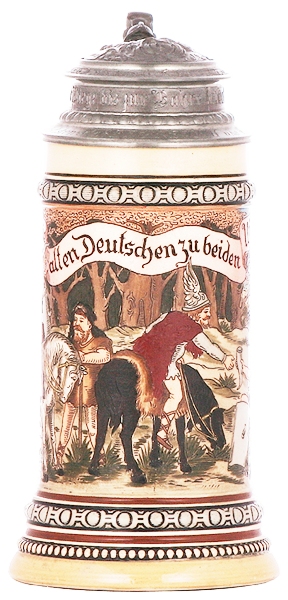 [TSACO]
[TSACO]
FOR AN INTERESTING (AND A BIT FAST MOVING) VIDEO OF THE BATTLE, PLEASE SEE:
http://www.youtube.com/watch?v=OxilvLpCT7U&feature=related
AND TO REALIZE SOME OF THE POLITICAL RAMIFICATIONS, SEE:
http://www.youtube.com/watch?v=s4W6YKeQNnI&feature=related
[END – SOK – RD – 34 – NODD]
 “My psychiatrist told me I was crazy and I said I want a second opinion. He said okay, you’re old and ugly too.”
“My psychiatrist told me I was crazy and I said I want a second opinion. He said okay, you’re old and ugly too.”

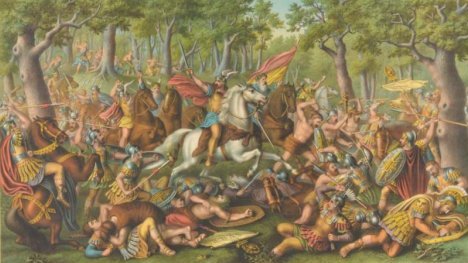
Leave a Reply